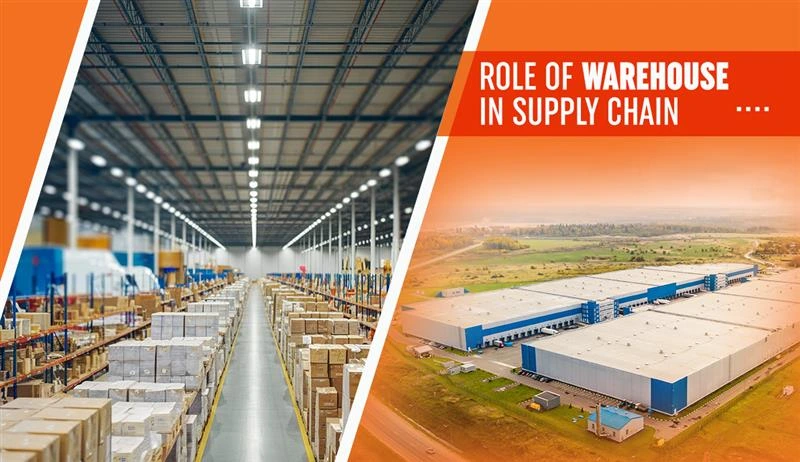Warehouses are the core of an efficient and resilient supply chain. They act as strategic hubs that store, organize, and dispatch goods to ensure smooth business operations. A warehouse not only bridges the gap between manufacturers and end-users but also supports businesses in handling demand fluctuations effectively. In this competitive market, where customers expect quick deliveries and error-free service, warehouses provide the backbone that keeps operations running smoothly. By optimizing storage, streamlining logistics, and minimizing product loss, a well-managed warehouse contributes directly to profitability and customer satisfaction. Understanding their crucial roles can help businesses build stronger, more reliable supply chains.
Role Of a Warehouse In The Supply Chain
Storage of Goods
The primary function of a warehouse is to provide secure and organized storage for goods. Businesses often face seasonal demand fluctuations, and having a dedicated storage facility ensures that products are available when the market requires them. Warehouses protect inventory from environmental damage, theft, and deterioration through controlled storage conditions. Modern facilities come with advanced features such as temperature control, racking systems, and security surveillance for maximum safety. Effective storage also helps companies reduce clutter at production sites and retail outlets. As businesses expand, investing in Industrial Properties For Sale becomes a strategic move to develop larger and more efficient storage hubs that meet growing demands.
Inventory Management
An efficient warehouse simplifies inventory control and enhances supply chain visibility. Through warehouse management systems (WMS), companies can track stock levels, product locations, and movement in real time. This accuracy minimizes the risk of overstocking, understocking, or stockouts that could disrupt operations. Well-managed inventory also reduces wastage and ensures perishable goods are dispatched on time. By understanding inventory trends, businesses can forecast demand and adjust procurement accordingly. For companies in metropolitan areas, acquiring Commercial Properties in Kolkata for modern warehousing solutions allows for better inventory tracking and supports the adoption of automated systems, improving operational efficiency and reducing human error.
Smooth Flow of Goods
Warehouses serve as transit hubs, ensuring the uninterrupted flow of goods across the supply chain. They receive shipments from manufacturers, sort products according to demand, and then dispatch them to distributors, retailers, or directly to customers. This role reduces transportation delays and ensures orders are fulfilled on time. Smooth product flow also helps companies meet peak season demands without additional stress. By organizing goods based on delivery schedules and regions, warehouses minimize confusion and optimize route planning. In industries that handle large volumes daily, such as e-commerce and FMCG, the warehouse’s ability to streamline movement is critical for business success.
Consolidation and Break-Bulk Operations
Warehouses play a key role in optimizing logistics costs through consolidation and break-bulk processes. Consolidation involves combining smaller shipments from multiple suppliers into one large shipment, making transportation more cost-effective. On the other hand, break-bulk operations involve dividing a large shipment into smaller packages for distribution to multiple destinations. These processes reduce the number of trips, lower fuel consumption, and improve delivery efficiency. This flexibility allows businesses to cater to diverse customers across different locations without maintaining multiple storage units. Companies that leverage these services can offer faster deliveries at reduced logistics costs, which strengthens overall supply chain performance.
Value Addition to Products
Modern warehouses are no longer just storage facilities; they also provide value-added services that enhance customer experience. Activities like labeling, barcoding, repackaging, kitting, and even product customization are often performed before dispatch. These services save businesses time and costs by reducing the need for separate facilities. For example, products can be assembled into promotional bundles or packed with brand-specific labels, ready for retail. Some warehouses also manage returns and quality checks, ensuring only approved goods reach customers. By performing these additional tasks, warehouses transform into operational assets that boost efficiency, improve brand reputation, and increase customer satisfaction.
Risk Management
A warehouse safeguards inventory from multiple risks that can disrupt the supply chain. Proper infrastructure, such as fire safety systems, security surveillance, and climate control, ensures that goods remain protected against theft, accidents, and environmental damage. Insurance coverage and adherence to safety regulations further reduce financial risks. In industries dealing with sensitive products like pharmaceuticals, chemicals, and food items, warehouses implement strict quality controls and hygiene protocols to preserve product integrity. By minimizing risk, warehouses allow businesses to focus on growth without worrying about sudden inventory losses. Reliable risk management is essential for building a trustworthy and consistent supply chain.
Enhancing Customer Satisfaction
Ultimately, the warehouse’s efficiency directly impacts the end customer. Timely deliveries, accurate order fulfillment, and the availability of products contribute to a positive buying experience. Strategic warehouse locations reduce shipping distances and shorten delivery timelines, which is critical for businesses in e-commerce and retail. When customers receive products quickly and in perfect condition, they are more likely to remain loyal to the brand. Additionally, the ability to handle urgent orders or returns smoothly further strengthens customer relationships. A strong warehouse network transforms supply chains into customer-focused systems that support repeat business and long-term growth.
The Bottom Line
Warehouses are the heartbeat of modern supply chains, driving efficiency and reliability at every stage. They go far beyond simple storage, contributing to smooth product movement, risk management, and enhanced customer satisfaction. With the rise of automation and smart inventory management, warehouses are evolving into strategic hubs that add value to the overall business. Companies that invest in efficient warehousing enjoy faster deliveries, reduced costs, and higher customer loyalty. In a competitive market where speed and accuracy matter, a robust warehousing system remains essential for long-term supply chain success.









